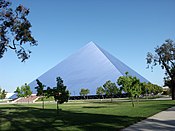
Canberra Stadium is a facility primarily used for rugby league and rugby union games, located adjacent to the Australian Institute of Sport in Canberra, the capital of Australia. It is the largest sports venue by capacity in Canberra.

Dignity Health Sports Park is a multi-use sports complex located on the campus of California State University, Dominguez Hills in Carson, California. The complex consists of the 27,000-seat Dignity Health Sports Park soccer stadium, the Dignity Health Sports Park tennis stadium, a track-and-field facility, and the VELO Sports Center velodrome. It is approximately 14 miles (23 km) south of downtown Los Angeles, and its primary tenant is the LA Galaxy of Major League Soccer (MLS). The main stadium was also home to the Los Angeles Wildcats of the XFL in 2020. The LA Galaxy II of MLS Next Pro play their home matches at the complex's track and field facility. For 2020 and 2021, the stadium served as the temporary home of the San Diego State Aztecs football team.

The Los Angeles Memorial Coliseum is a multi-purpose stadium in the Exposition Park neighborhood of Los Angeles, California, United States. Conceived as a hallmark of civic pride, the Coliseum was commissioned in 1921 as a memorial to Los Angeles veterans of World War I. Completed in 1923, it will become the first stadium to have hosted the Summer Olympics three times when it hosts the 2028 Summer Olympics; the stadium previously hosted the Summer Olympics in 1932 and 1984. It was designated a National Historic Landmark on July 27, 1984, a day before the opening ceremony of the 1984 Summer Olympics.

Central Energy Trust Arena is the current name of the 180,000 square metre publicly owned recreational complex just west of the Palmerston North city centre in the Manawatū-Whanganui region of New Zealand.
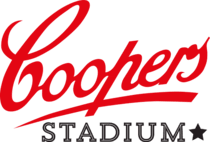
Hindmarsh Stadium is a multi-purpose stadium in Hindmarsh, an inner western suburb of Adelaide, South Australia. It is the home of the Australian A-League team, Adelaide United.

Odsal Stadium in Bradford, West Yorkshire, England, is a multi-purpose stadium currently the home of Bradford Bulls Rugby League team and Yorstox Stock Cars who host regular monthly meetings of BriSCA F1 Stock Cars and BriSCA F2 Stock Cars. It has also been used by the Bradford Dukes speedway team, hosting the 1997 Speedway Grand Prix of Great Britain. The football team Bradford City used Odsal as a temporary groundshare following the Valley Parade fire while their ground was rebuilt. Odsal Stadium has also historically hosted baseball, American Football, basketball, kabbadi, show jumping, tennis, live music concerts, and international Rugby League matches over the years.

Parramatta Stadium was a sports stadium in Parramatta, New South Wales, Australia, 23 kilometres west of Sydney's central business district. The stadium was the home ground of several western Sydney-based sports teams, at the time of closure the most notable were the Parramatta Eels of the National Rugby League and the Western Sydney Wanderers of the A-League.

Gilmore Stadium was a multi-purpose stadium in Los Angeles, California. It was opened in May 1934 and demolished in 1952, when the land was used to build CBS Television City. The stadium held 18,000. It was located next to Gilmore Field. The stadium was located west of Curson Avenue, surrounded by Beverly Boulevard, Fairfax Avenue and Third Street. The stadium was used in a Three Stooges 1934 short Three Little Pigskins.

Olympic Park Stadium was a multi-purpose outdoor stadium located on Olympic Boulevard in inner Melbourne, Australia. The stadium was built as an athletics training venue for the 1956 Olympics, a short distance from the Melbourne Cricket Ground, which served as the Olympic Stadium. Over the years it was the home of rugby league side, Melbourne Storm and the A-League team, Melbourne Victory; throughout its life the stadium played host to athletics. Olympic Park Stadium was located in Olympic Park, which is part of the Melbourne Sports and Entertainment Precinct.

Henson Park is a multi purpose sports ground in Marrickville, New South Wales, Australia.

California has 21 major professional sports franchises, far more than any other US state. The San Francisco Bay Area has six major league teams spread amongst three cities: San Francisco, Oakland and San Jose. The Greater Los Angeles Area has ten major league teams. San Diego and Sacramento each have one major league team.

The Greater Los Angeles area is home to many professional and collegiate sports teams and has hosted many national and international sporting events. The metropolitan area has twelve major league professional teams: the Los Angeles Lakers, the Los Angeles Dodgers, the Los Angeles Rams, the Los Angeles Clippers, the Los Angeles Angels, LA Galaxy, Los Angeles FC, the Los Angeles Kings, the Los Angeles Chargers, Los Angeles Sparks, the Anaheim Ducks, the Los Angeles Knight Riders of the MLC Major League Cricket, their Minor League Cricket affiliate SoCal Lashings, and Angel City FC of the National Women's Soccer League. The Los Angeles metropolitan area is home to nine universities whose teams compete in various NCAA Division I level sports, most notably the UCLA Bruins and USC Trojans. Between them, these Los Angeles area sports teams have won a combined 105 championship titles. Los Angeles area colleges have produced upwards of 200 national championship teams.
The Pacific Coast Professional Football League (PCPFL), also known as the Pacific Coast Football League (PCFL) and Pacific Coast League (PCL) was a professional American football minor league based in California. It operated from 1940 through 1948. One of the few minor American professional sports leagues that competed in the years of World War II, the PCPFL was regarded as a minor league of the highest level, particularly from 1940 to 1945, at a time in which the National Football League (NFL) did not extend further west than Chicago and Green Bay. It was also the first professional football league to have a team based in Hawaii.

The Los Angeles Bulldogs were a professional American football team that competed from 1936 to 1948. Formed with the intention of joining the National Football League in 1937, the Bulldogs were the first team on the major league level to play its home games on the American West Coast. They were considered "the best football team in existence outside the NFL".
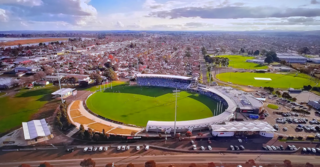
Eureka Stadium, known commercially as Mars Stadium, is an oval-shaped sports stadium located in the Eureka Sports Precinct of Wendouree, 2.9 km (1.8 mi) north of the CBD of the city of Ballarat, Victoria, Australia.
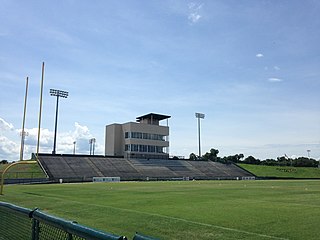
Spec Martin Stadium is a 6,000 seat football stadium located in DeLand, Florida. Spec Martin Stadium currently hosts Stetson Hatters football, DeLand High School Bulldog football and was the host of the Central Florida Warriors rugby league team. The stadium was known as DeLand Municipal Stadium from is opening in 1941 until it was renamed in 1973.

Sydney Showground Stadium is a sports and events stadium located at the Sydney Showground in Sydney Olympic Park suburb of Sydney, New South Wales, Australia. It hosted the baseball events for the 2000 Summer Olympics. The Showground, including the stadium, is operated by the Royal Agricultural Society of NSW (RAS), under lease from the New South Wales Government.
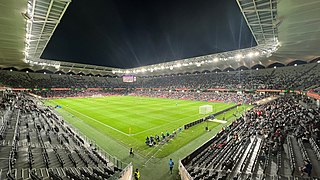
Western Sydney Stadium, commercially known as CommBank Stadium, is a multi-purpose rectangular stadium in Parramatta, within the Greater Western Sydney region, approximately 24 km (15 mi) west of Sydney CBD. It replaced the demolished Parramatta Stadium (1986) which in turn was built on the site of the old Cumberland Oval, home ground to the Parramatta Eels since 1947. The current stadium opened in April 2019 and has a 30,000-seat capacity. The stadium is owned by the NSW Government and built at a cost of $300 million. The stadium hosts games across the major rectangular field sports in Sydney.

BMO Stadium, formerly Banc of California Stadium, is a soccer-specific stadium in the Exposition Park neighborhood of Los Angeles, California. It is the home of Major League Soccer's Los Angeles FC and the National Women's Soccer League's Angel City FC. Opened on April 18, 2018, it was the first open-air stadium built in the City of Los Angeles since Dodger Stadium in 1962. Constructed on the site of the former Los Angeles Memorial Sports Arena, it is located next to the Los Angeles Memorial Coliseum and just south of the main campus of the University of Southern California. Los Angeles FC subleases the site from the University which has a master lease with the LA Memorial Coliseum Commission for operating and managing the Coliseum and stadium properties.
The Long Beach Admirals were a professional American football team based in Long Beach, California.





















